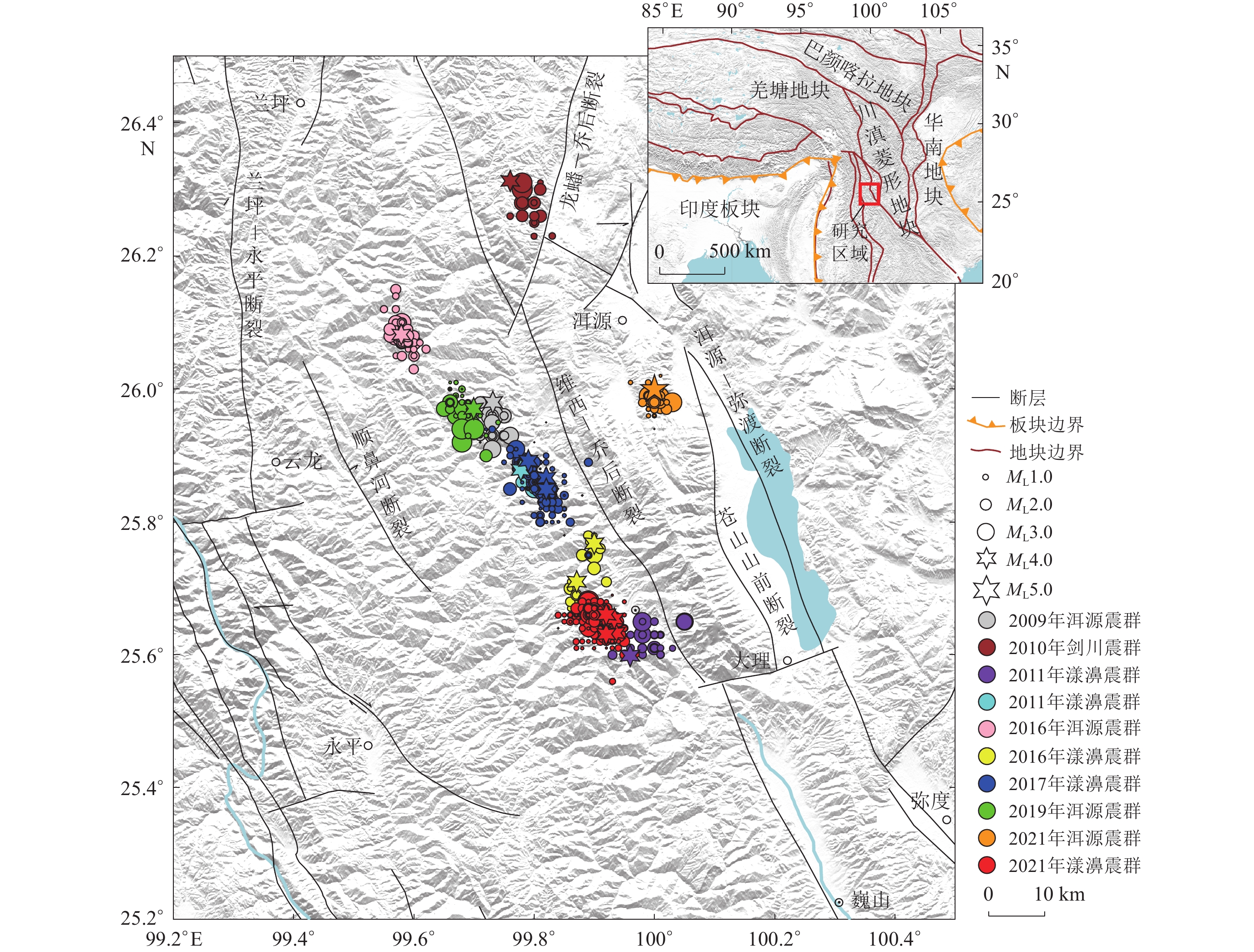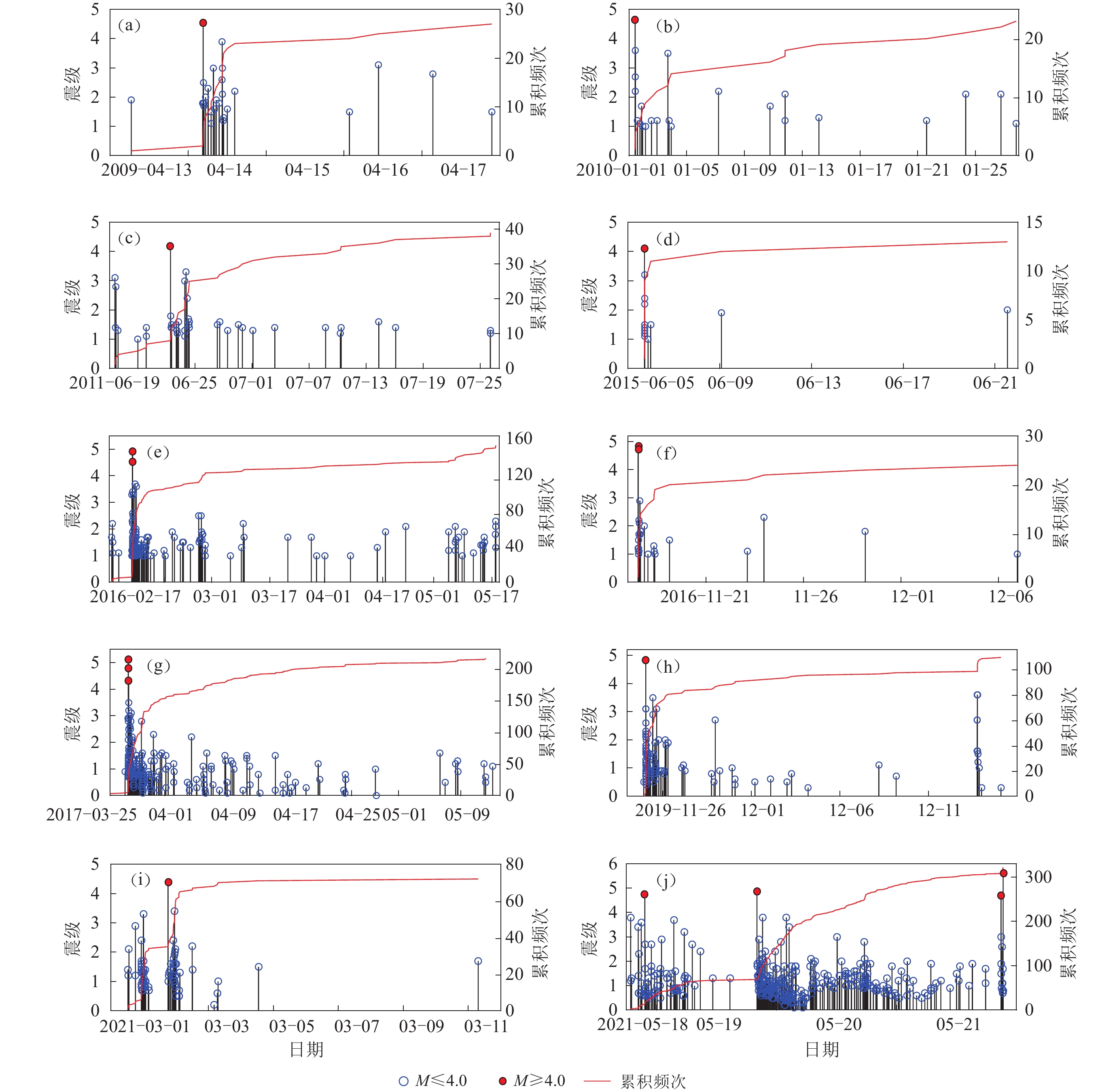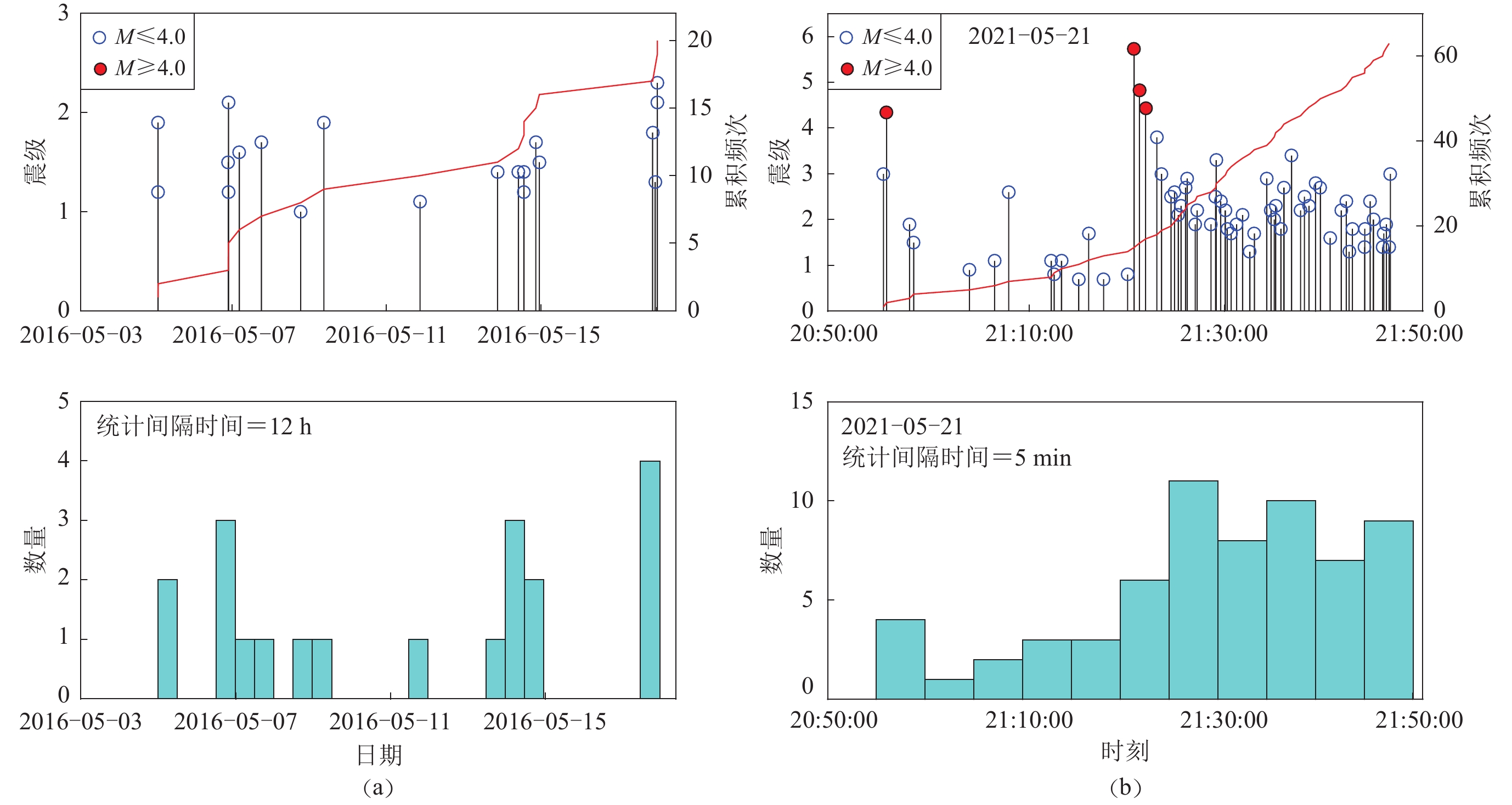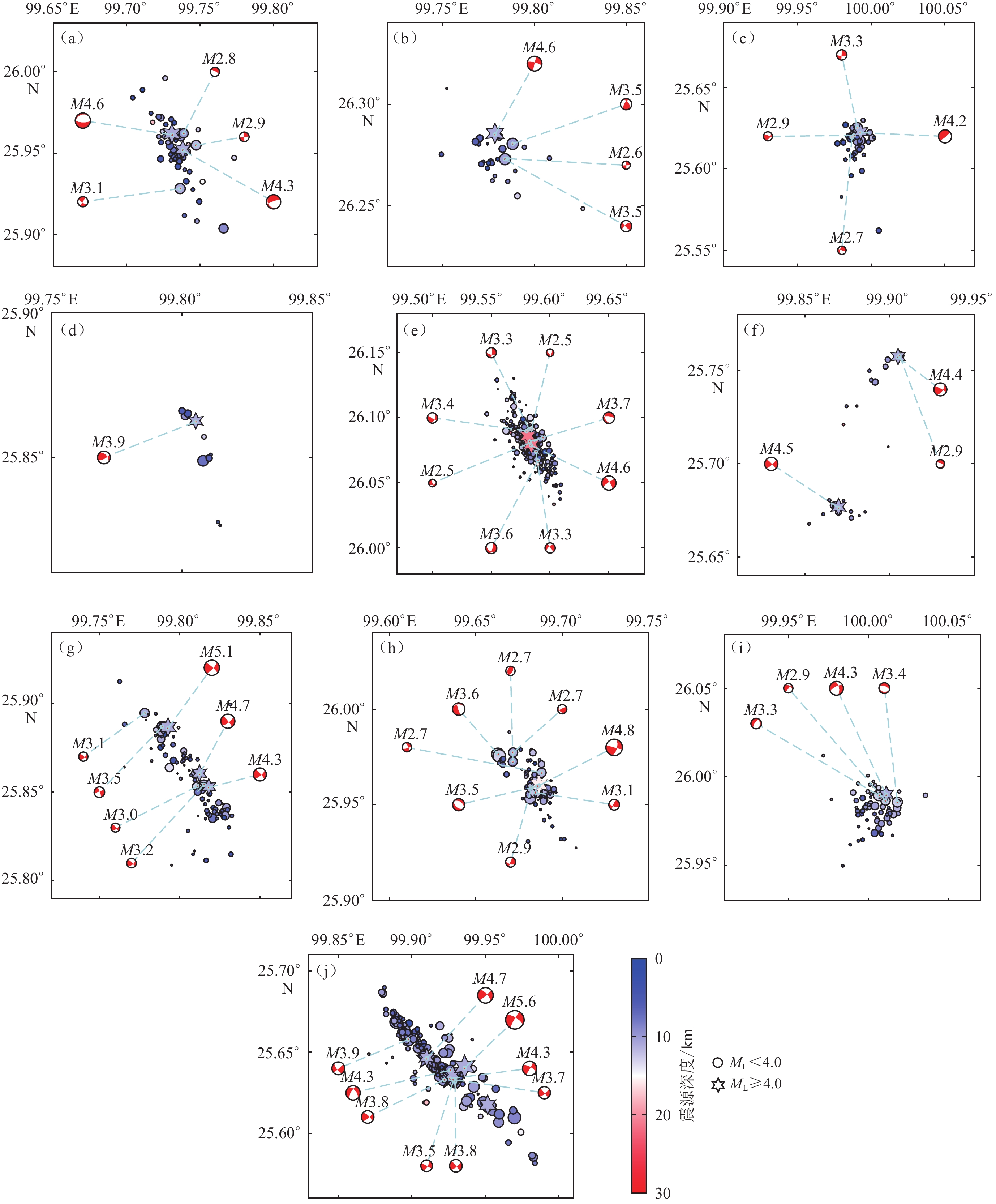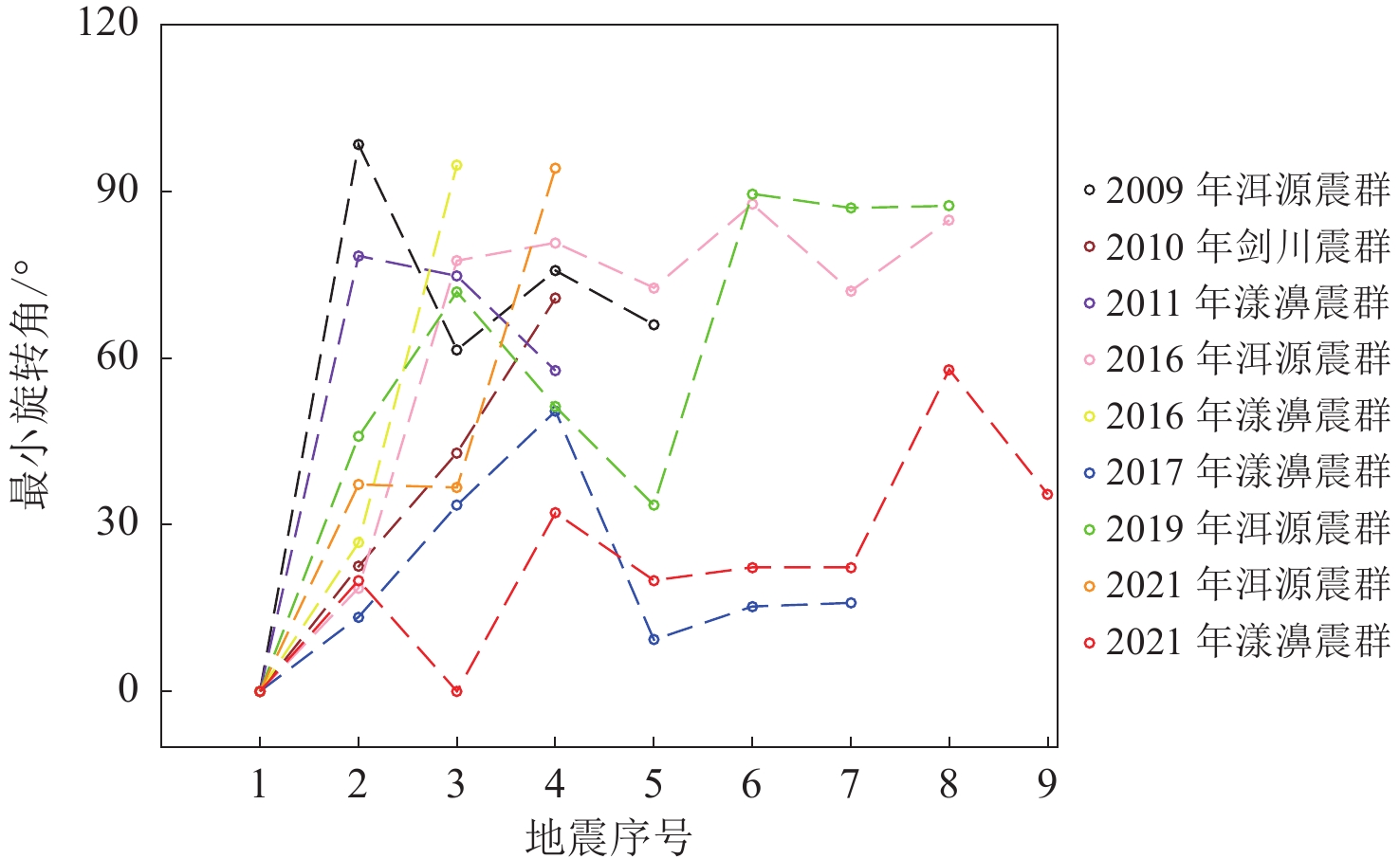Characteristics of earthquake swarms and foreshock sequences in Weixi-Qiaohou fault zone and its surrounding areas
-
摘要:
使用云南地震台网2009—2021年的地震目录和波形数据,采用双差定位方法、基于P波初动极性和S/P振幅比的HASH方法和最大似然法等,获取了维西—乔后断裂带及附近地区ML≥4.0震群和前震序列精确的震源位置、震源机制解、视应力和b值等地震活动参数,对比分析了维西—乔后断裂带及其周边震群及前震序列的活动特征。结果显示:除前震序列频次呈现出反大森定律外,前震序列与普通震群在空间分布、震源机制一致性、视应力和b值等单一参数方面并无明显的差异;但前震序列同时具备震中优势分布方向与区域主要构造展布方向一致、震源机制一致性较好、低b值等特征,建议综合使用时空演化特征、震群参数识别前震序列。
Abstract:The 2021 MS6.4 Yangbi earthquake in the Weixi-Qiaohou fault zone is preceded by a prominent foreshock activity, and earthquake swarms are frequently recorded in this area. Thus, it provides a valuable opportunity to study the differences between foreshock sequences and ordinary earthquake swarms and to develop recognition features of foreshocks.
Referring to the specific definition of earthquake swarms in previous studies and the actual seismicity characteristics of the Weixi-Qiaohou fault zone and its surrounding areas, eight earthquake swarms and two foreshock sequences involving ML≥4.0 earthquakes are selected based on the following criteria: ① The epicenters of the earthquake swarm are distributed in a rectangular area of not more than 2500 km2, and there is a clear boundary separated from the distribution of background earthquakes; ② The maximum daily frequency is not less than 3, and the total frequency is not less than 10; ③ The magnitude difference between the largest and second largest earthquakes $\Delta $ML≤1.6; ④ If ML≥1.0 earthquakes are not recorded for 15 consecutive days before and after the start and end of the earthquake sequence, the date of the first earthquake is the starting date of the earthquake sequence, and the date of the last earthquake is the ending date of the sequence. ⑤ For the foreshock sequence, the date of the first earthquake is the starting date of the sequence, and the date of the last earthquake before the main shock is the ending date of the sequence. First, we use the double-difference relocation algorithm to obtain precise relative locations of ten earthquake sequences. Secondly, we collect focal mechanism solutions of ML≥2.5 earthquakes in these sequences from previous studies and calculate focal mechanism solutions of those missing important earthquakes by HASH. This study use the minimum 3-D rotation angle to present the focal mechanism consistency of the ten earthquake sequences. Thirdly, we calculate the apparent stress of ML≥3.0 earthquakes of these sequences using waveform data provided by Yunnan Seismological Network. Finally, we apply the maximum likelihood method to calculate the b values of four earthquake sequences, while the other six sequences did not have enough earthquakes to obtain the b value.
Earthquake swarms and foreshock sequences are analyzed in detail based on spatiotemporal evolution characteristics, focal mechanism and apparent stress of larger earthquakes, and sequence b value. After analysis, we acquire the following characteristics of the earthquake swarms and the foreshock sequences located in the Weixi-Qiaohou fault zone and its surrounding areas: ① Before the occurrence of the mainshock, the frequency of the foreshock sequence shows a quiet-enhanced evolution characteristic, which is consistent with the anti-Omori law. However, ordinary earthquake swarms show different evolutionary characteristics, that is, rapid attenuation after the occurrence of the largest earthquake of the swarms. ② The epicenters of foreshock sequences show an obvious dominant distribution direction, which is consistent with the strike of the main active fault in the region, and the spatial distribution is relatively concentrated. The spatial distribution characteristics of earthquake swarms are inconsistent. There are both earthquake swarms with obvious dominant distribution direction and circular distribution. ③ The focal mechanism consistency of ten earthquake sequences is complicated. The focal mechanism solutions of the 2017 Yangbi earthquake swarm and the 2021 Yangbi foreshock sequence have good consistency, respectively. However, no stronger earthquake has occurred after the 2017 Yangbi earthquake swarm in the focal area of the swarm. ④ The apparent stress of earthquake swarms and foreshock sequences located in the Weixi-Qiaohou fault zone and its surrounding areas is the same as that in the northwest of Yunnan, and the apparent stress of the foreshock did not show a prominent characteristic. ⑤ The b values of earthquake swarms and foreshock sequences show that the Weixi-Qiaohou fault zone and its surrounding areas have a relatively lower b value. There is no significant difference in the b value between foreshock sequences and ordinary earthquake swarms.
In summary, there is no noticeable difference in spatial distribution, focal mechanism consistency, apparent stress, and b value between the foreshock sequences and the common earthquake swarms except for the anti-Omori law of frequency of the foreshock sequences. However, the foreshock sequences have the following three characteristics in spatial distribution and seismic parameters simultaneously: ① The dominant distribution direction of epicenters is consistent with the strike of the main active fault in the region; ② The focal mechanism solutions of the sequence have good consistency; ③ The sequence has a lower b value. It is suggested that spatio-temporal evolution characteristics and seismicity parameters should be used together to identify foreshock sequences in the future.
-
-
图 2 维西—乔后断裂带周边地区M4.0震群分布及研究区周边地块分布
图中断层和活动地块边界数据分别来自安晓文和常祖峰(2018)和张培震等(2003),地形数据引自Tozer等(2019)
Figure 2. Distribution of ML≥4.0 earthquake swarms in Weixi-Qiaohou fault zone and its surrounding blocks
Geological data and boundary data of active-tectonic block are cited from An and Chang (2018) and Zhang et al (2003),topographic relief data is from Tozer et al (2019)
图 3 维西—乔后断裂带及周边10组震群M-t图(左)和累积频次图(右)
(a) 2009年洱源震群;(b) 2010年剑川震群;(c) 2011年漾濞震群;(d) 2015年洱源震群;(e) 2016年洱源震群;(f) 2016年漾濞震群;(g) 2017年漾濞震群;(h) 2019年洱源震群;(i) 2021年洱源震群;(j) 2021年漾濞震群
Figure 3. M-t diagram (a) and cumulative frequency diagram (b) of 10 earthquake swarms in Weixi-Qiaohou fault zone and its surrounding area
(a) 2009 Eryuan earthquake swarm;(b) 2010 Jianchuan earthquake swarm;(c) 2011 Yangbi earthquake swarm;(d) 2015 Eryuan earthquake swarm;(e) 2016 Eryuan earthquake swarm;(f) 2016 Yangbi earthquake swarm;(g) 2017 Eryuan earthquake swarm;(h) 2019 Eryuan earthquake swarm;(i) 2021 Eryuan earthquake swarm;(j) 2021 Yangbi earthquake swarm
图 5 震群重定位后震中分布
(a) 2009年洱源震群;(b) 2010年剑川震群;(c) 2011年漾濞震群;(d) 2015年洱源震群;(e) 2016年洱源震群;(f) 2016年漾濞震群;(g) 2017年漾濞震群;(h) 2019年洱源震群;(i) 2021年洱源震群;(j) 2021年漾濞震群
Figure 5. Epicenter distribution of earthquake swarms after relocation
(a) 2009 Eryuan earthquake swarm;(b) 2010 Jianchuan earthquake swarm;(c) 2011 Yangbi earthquake swarm;(d) 2015 Eryuan earthquake swarm;(e) 2016 Eryuan earthquake swarm;(f) 2016 Yangbi earthquake swarm;(g) 2017 Eryuan earthquake swarm;(h) 2019 Eryuan earthquake swarm;(i) 2021 Eryuan earthquake swarm;(j) 2021 Yangbi earthquake swarm
表 1 维西—乔后断裂带及周边地区10组震群基本信息
Table 1 Information of ten earthquake swarms in Weixi-Qiaohou fault zone and its surrounding areas
震群 最大震级 地震次数 持续时间/d 最大与次大地震的震级差$\Delta$ ML 2 009年洱源震群 4.4 27 5 0.5 2 010年剑川震群 4.6 23 27 1.6 2 011年漾濞震群 3.7 39 41 0.9 2 015年洱源震群 3.6 13 17 0.9 2 016年洱源震群 4.5 159 107 0.4 2 016年漾濞震群 4.4 24 2 0 0.1 2 017年漾濞震群 5.1 216 45 0.4 2 019年洱源震群 4.3 109 22 1.2 2 021年洱源震群 3.8 72 12 0.9 2 021年漾濞震群 5.6 322 3 0.2 表 2 维西—乔后断裂带及其周边地区震群序列中ML≥3.0地震的视应力
Table 2 Apparent stress of ML≥3.0 earthquakes of the earthquake swarms in Weixi-Qiaohou fault zone and its surrounding areas
震群序号 震群名称 ML 发震日期 发震时刻 视应力 1 2 009年洱源震群 4.6 2 009-04-14 04:37:09 0.103 807 3.1 2 009-04-16 10:36:43 0.013 749 2 2 010年剑川震群 5.0 2 010-01-01 10:08:21 0.126 987 3 2 011年漾濞震群 2.9 2 011-06-16 13:30:35 0.040 069 4.2 2 011-06-22 09:42:07 0.034 772 3.3 2 011-06-24 00:52:53 0.009 46 4 2 015年洱源震群 4.4 2 015-06-05 17:06:06 0.041 206 5 2 016年洱源震群 4.5 2 016-02-08 07:39:09 0.031 483 6 2 016年漾濞震群 4.9 2 016-11-17 12:22:47 0.130 816 7 2 017年漾濞震群 5.5 2 017-03-27 07:55:02 0.174 595 8 2 019年洱源震群 4.8 2 019-11-25 01:02:35 0.068 7 3.5 2 019-11-25 10:33:53 0.026 6 9 2 021年洱源震群 4.3 2 021-03-01 18:13:13 0.086 3.4 2 021-03-01 22:59:18 0.009 92 10 2 021年漾濞震群 3.6 2 021-05-18 2 0:56:46 0.029 1 4.7 2 021-05-18 21:39:35 0.056 1 3.2 2 021-05-19 05:33:24 0.011 2 4.8 2 021-05-19 2 0:05:56 0.046 8 3.8 2 021-05-19 21:13:07 0.025 7 3.0 2 021-05-20 12:08:41 0.017 9 3.4 2 021-05-21 21:37:33 0.035 1 表 3 维西—乔后断裂带及周边地区M≥4.0震群b值
Table 3 b-value of M≥4.0 earthquake swarms in Weixi-Qiaohou fault zone and its surrounding areas
序号 震群名称 b值 MC 1 2016年洱源震群 0.78 1.3 2 2017年漾濞震群 0.64 1.5 3 2021年洱源震群 0.76 1.4 4 2021年漾濞震群 0.67 0.9 -
安晓文,常祖峰. 2018. 云南第四纪活动断裂暨:云南第四纪活动断裂分布图[M]. 北京:地震出版社:11−19. An X W,Chang Z F. 2018. Quaternary Active Faults in Yunnan:Distribution Map of Quaternary Active Faults in Yunnan[M]. Beijing:Seismological Press:11−19 (in Chinese).
曹凤娟,翟丽娜,殷轶娜,杨牧萍,张慧,张博. 2015. 辽宁地区震群序列统计特征及预测意义研究[J]. 中国地震,31(1):45–55. doi: 10.3969/j.issn.1001-4683.2015.01.005 Cao F J,Zhai L N,Yin Y N,Yang M P,Zhang H,Zhang B. 2015. The study on the statistical characteristics of the earthquake swarms in Liaoning and the prediction significance[J]. Earthquake Research in China,31(1):45–55 (in Chinese).
崔华伟,郑建常,万永革,程宇豪,杨帆,孙庆山,赵瑞,许鑫,柴光斌. 2022. 2021年云南漾濞MS6.4地震序列发震构造及其与2013年洱源、2017年漾濞地震的异同[J]. 地球物理学报,65(2):620–636. doi: 10.6038/cjg2022P0425 Cui H W,Zheng J C,Wan Y G,Cheng Y H,Yang F,Sun Q S,Zhao R,Xu X,Chai G B. 2022. The seismogenic structure of the 2021 Yunnan Yangbi MS6.4 earthquake sequence and the difference between the Eryuan earthquake in 2013,Yangbi earthquake in 2017 and 2021[J]. Chinese Journal of Geophysics,65(2):620–636 (in Chinese).
邓世广,蒋海昆. 2022. 2020年伽师MS6.4地震前震活动研究[J]. 地球物理学报,65(9):3322–3334. doi: 10.6038/cjg2022P0488 Deng S G,Jiang H K. 2022. Investigation of the foreshock activity of the 2020 MS6.4 Jiashi earthquake[J]. Chinese Journal of Geophysics,65(9):3322–3334 (in Chinese).
段梦乔,赵翠萍,周连庆,赵策,左可桢. 2021. 2021年5月21日云南漾濞MS6.4地震序列发震构造[J]. 地球物理学报,(9):3111–3125. doi: 10.6038/cjg2021P0423 Duan M Q,Zhao C P,Zhou L Q,Zhao C,Zuo K Z. 2021. Seismogenic structure of the 21 May 2021 MS6.4 Yunnan Yangbi earthquake sequence[J]. Chinese Journal of Geophysics,64(9):3111–3125 (in Chinese).
冯建刚,张辉,杨萍. 2016. 2013年岷县漳县6.6级地震前地震b值异常特征研究[J]. 地震,36(1):32–37. doi: 10.3969/j.issn.1000-3274.2016.01.004 Feng J G,Zhang H,Yang P. 2016. Anormalies of b-value changes before the 2013 Minxian-Zhangxian MS6.6 earthquake[J]. Earthquake,36(1):32–37 (in Chinese).
付虹,刘自凤,胡小静,李智蓉,洪敏,彭关灵,王光明,倪喆. 2021. 2021年云南漾濞MS6.4地震异常跟踪分析[J]. 地震研究,44(3):301–308. Fu H,Liu Z F,Hu X J,Li Z R,Hong M,Peng G L,Wang G M,Ni Z. 2021. Tracking analysis of seismic anomalies of the 2021 Yangbi,Yunnan MS6.4 earthquake[J]. Journal of Seismological Research,44(3):301–308 (in Chinese).
郭祥云,陈学忠,李艳娥,隗永刚,陈丽娟. 2019. 震源机制一致性的显著性检验方法:以1999年11月29日辽宁岫岩MS5.4地震前震序列为例[J]. 地震学报,41(6):709–722. doi: 10.11939/jass.20190045 Guo X Y,Chen X Z,Li Y E,Wei Y G,Chen L J. 2019. Significance test of focal mechanism consistency:Taking the foreshock sequence of the MS5.4 Xiuyan earthquake on November 29,1999 as an example[J]. Acta Seismologica Sinica,41(6):709–722 (in Chinese).
郭祥云,尹海权,汪贞杰,杨辉. 2021. 2021年5月21日云南漾濞M6.4地震序列的矩心矩张量解及动力环境分析[J]. 地震地质,43(4):806–826. doi: 10.3969/j.issn.0253-4967.2021.04.005 Guo X Y,Yin H Q,Wang Z J,Yang H. 2021. Earthquake centroid,seismic moment tensor and dynamic environment analysis of the MS6.4 earthquake sequence in Yangbi,Yunnan on May 21,2021[J]. Seismology and Geology,43(4):806–826 (in Chinese).
郭祥云,蒋长胜,韩立波,尹海权,赵志远. 2022. 中国大陆及邻区震源机制数据集(2009—2021年)[DB/OL]. [2022−03−01]. https://data.earthquake.cn/datashare/report.shtml?PAGEID=datasourcelist&dt=ff8080827e4d6cf5017f1f5b440d0019. Guo X Y,Jiang C S,Han L B,Yin H Q,Zhao Z Y. 2022. Focal mechanism data set in Chinese mainland and its adjacent area (2009−2021)[DB/OL]. [2022−03−01]. https://data.earthquake.cn/datashare/report.shtml?PAGEID=datasourcelist&dt=ff8080827e4d6cf5017f1f5b440d0019 (in Chinese).
蒋海昆,李永莉,曲延军,华爱军,代磊,郑建常,侯海峰. 2006. 中国大陆中强地震序列类型的空间分布特征[J]. 地震学报,28(4):389–398. doi: 10.3321/j.issn:0253-3782.2006.04.006 Jiang H K,Li Y L,Qu Y J,Hua A J,Dai L,Zheng J C,Hou H F. 2006. Spatial distribution features of sequence types of moderate and strong earthquakes in Chinese mainland[J]. Acta Seismologica Sinica,28(4):389–398 (in Chinese).
姜金钟,付虹,李涛. 2021. 2021年云南漾濞MS6.4地震序列重定位及发震构造探讨[J]. 地震研究,44(3):320–329. Jiang J Z,Fu H,Li T. 2021. Relocation of the 2021 Yangbi,Yunnan MS6.4 earthquake sequence and discussion of its seismogenic fault[J]. Journal of Seismological Research,44(3):320–329 (in Chinese).
雷兴林,王志伟,马胜利,何昌荣. 2021. 关于2021年5月滇西漾濞MS6.4地震序列特征及成因的初步研究[J]. 地震学报,43(3):261–286. doi: 10.11939/jass.20210100 Lei X L,Wang Z W,Ma S L,He C R. 2021. A preliminary study on the characteristics and mechanism of the May 2021 MS6.4 Yangbi earthquake sequence,Yunnan,China[J]. Acta Seismologica Sinica,43(3):261–286 (in Chinese).
刘俊清,甘卫军,王光明,王忠礼,张宇,蔡宏雷,李仲巍. 2021. 2021年5月21日云南漾濞MS6.4地震序列地震矩张量及发震构造[J]. 地球物理学报,64(12):4475–4487. doi: 10.6038/cjg2021P0559 Liu J Q,Gan W J,Wang G M,Wang Z L,Zhang Y,Cai H L,Li Z W. 2021. Seismic moment tensor and seismogenic structure of the Yangbi MS6.4 earthquake sequence on May 21,2021 in Yunnan[J]. Chinese Journal of Geophysics,64(12):4475–4487 (in Chinese).
龙锋,祁玉萍,易桂喜,吴微微,王光明,赵小艳,彭关灵. 2021. 2021年5月21日云南漾濞MS6.4地震序列重新定位与发震构造分析[J]. 地球物理学报,64(8):2631–2646. doi: 10.6038/cjg2021O0526 Long F,Qi Y P,Yi G X,Wu W W,Wang G M,Zhao X Y,Peng G L. 2021. Relocation of the MS6.4 Yangbi earthquake sequence on May 21,2021 in Yunnan Province and its seismogenic structure analysis[J]. Chinese Journal of Geophysics,64(8):2631–2646 (in Chinese).
陆远忠,宋俊高,戴维乐. 1984. 一个判断震情的指标:震群U值[J]. 地震学报,6(增刊):495–508. Lu Y Z,Song J G,Dai W L. 1984. An index to judge the earthquake situation:The U value of earthquake swarm[J]. Acta Seismologica Sinica,6(S):495–508 (in Chinese).
万永革. 2019. 同一地震多个震源机制中心解的确定[J]. 地球物理学报,62(12):4718–4728. doi: 10.6038/cjg2019M0553 Wan Y G. 2019. Determination of center of several focal mechanisms of the same earthquake[J]. Chinese Journal of Geophy sics,62(12):4718–4728 (in Chinese).
王光明,彭关灵,赵小艳,付虹. 2021a. 基于地震序列时空分布特征分析维西—乔后断裂带地震危险性[J]. 地震研究,44(3):367–379. Wang G M,Peng G L,Zhao X Y,Fu H. 2021a. Seismic risk of the Weixi-Qiaohou fault zone based on temporal-spatial distribution characteristics of earthquake sequences[J]. Journal of Seismological Research,44(3):367–379 (in Chinese).
王光明,吴中海,彭关灵,刘自凤,罗睿洁,黄小龙,陈浩朋. 2021b. 2021年5月21日漾濞MS6.4地震的发震断层及其破裂特征:地震序列的重定位分析结果[J]. 地质力学学报,27(4):662–678. Wang G M,Wu Z H,Peng G L,Liu Z F,Luo R J,Huang X L,Chen H P. 2021b. Seismogenic fault and it’s rupture characteristics of the 21 May,2021 Yangbi MS6.4 earthquake:Analysis results from the relocation of the earthquake sequence[J]. Journal of Geomechanics,27(4):662–678 (in Chinese).
王月,胡少乾,何骁慧,郭凯,解孟雨,邓世广,马亚伟. 2021. 2021年5月21日云南漾濞6.4级地震序列重定位及震源机制研究[J]. 地球物理学报,64(12):4510–4525. doi: 10.6038/cjg2021P0401 Wang Y,Hu S Q,He X H,Guo K,Xie M Y,Deng S G,Ma Y W. 2021. Relocation and focal mechanism solutions of the 21 May 2021 MS6.4 Yunnan Yangbi earthquake sequence[J]. Chinese Journal of Geophysics,64(12):4510–4525 (in Chinese).
薛艳,解孟雨,刘杰,庄建仓. 2021. 全球MW≥8.0浅源地震的前震序列研究[J]. 地震地质,43(5):1233–1249. Xue Y,Xie M Y,Liu J,Zhuang J C. 2021. Study on foreshock sequences of the global great shallow-focus earthquakes with MW≥8.0[J]. Seismology and Geology,43(5):1233–1249 (in Chinese).
闫坤,王伟君,冯磊,彭菲,寇华东,袁爱璟,付广裕. 2023. 2012年以来新疆于田强震前震序列的时空演化模式[J]. 地球物理学报,66(1):245–259. doi: 10.6038/cjg2022Q0020 Yan K,Wang W J,Feng L,Peng F,Kou H D,Yuan A J,Fu G Y. 2023. The foreshock temporal-spatial evolutionary patterns of the strong earthquakes since 2012 in Yutian,Xinjiang,China[J]. Chinese Journal of Geophysics,66(1):245–259 (in Chinese).
杨军,苏有锦,李孝宾,叶泵,陈佳. 2015. 2013年洱源MS5.5地震序列ML≥3.4地震的震源机制解研究[J]. 地震研究,38(2):196–202. Yang J,Su Y J,Li X B,Ye B,Chen J. 2015. Research on focal mechanism solutions of ML≥3.4 earthquakes of Eryuan MS5.5 earthquake sequence in 2013[J]. Journal of Seismological Research,38(2):196–202 (in Chinese).
曾宪伟,赵小艳,李蒙亚,李文君,唐浩,袁媛. 2022. 2021年5月21日漾濞4次MS≥5.0地震前后b值变化[J]. 地震学报,44(3):401–412. doi: 10.11939/jass.20210129 Zeng X W,Zhao X Y,Li M Y,Li W J,Tang H,Yuan Y. 2022. Variation of b-value before and after Yangbi four MS≥5.0 earthquakes on May 21,2021[J]. Acta Seismologica Sinica,44(3):401–412 (in Chinese).
张培震,邓起东,张国民,马瑾,甘卫军,闵伟,毛凤英,王琪. 2003. 中国大陆的强震活动与活动地块[J]. 中国科学(D辑),33(增刊):12–20. Zhang P Z,Deng Q D,Zhang G M,Ma J,Gan W J,Min W,Mao F Y,Wang Q. 2003. Active tectonic blocks and strong earthquakes in the continent of China[J]. Science in China:Series D,46(Z2):13–24.
赵博,高原,马延路. 2022. 2021年5月21日云南漾濞MS6.4地震序列重新定位、震源机制及应力场反演[J]. 地球物理学报,65(3):1006–1020. doi: 10.6038/cjg2022P0497 Zhao B,Gao Y,Ma Y L. 2022. Relocations,focal mechanisms and stress inversion of the May 21th 2021 Yangbi MS6.4 earthquake sequence in Yunnan,China[J]. Chinese Journal of Geophysics,65(3):1006–1020 (in Chinese).
赵小艳,孙楠,苏有锦. 2015. 云南地区前震时空分布及其统计特征研究[J]. 中国地震,31(2):209–217. doi: 10.3969/j.issn.1001-4683.2015.02.004 Zhao X Y,Sun N,Su Y J. 2015. Spatial-temporal distribution and their statistical characteristics of foreshocks in the Yunnan region[J]. Earthquake Research in China,31(2):209–217 (in Chinese).
Chen X W,Shearer P M. 2013. California foreshock sequences suggest aseismic triggering process[J]. Geophys Res Lett,40(11):2602–2607. doi: 10.1002/grl.50444
Chen Y,Liu J,Ge H K. 1999. Pattern characteristics of foreshock sequences[J]. Pure Appl Geophys,155(2):395–408.
Gomberg J. 2018. Unsettled earthquake nucleation[J]. Nat Geosci,11(7):463–464. doi: 10.1038/s41561-018-0149-x
Gulia L,Wiemer S. 2019. Real-time discrimination of earthquake foreshocks and aftershocks[J]. Nature,574(7777):193–199. doi: 10.1038/s41586-019-1606-4
Gutenberg B,Richter C F. 1944. Frequency of earthquakes in California[J]. Bull Seismol Soc Am,34(4):185–188. doi: 10.1785/BSSA0340040185
Jiang J Z,Li J,Fu H. 2019. Seismicity analysis of the 2016 MS5.0 Yunlong earthquake,Yunnan,China and its tectonic implications[J]. Pure Appl Geophys,176(3):1225–1241. doi: 10.1007/s00024-018-2067-7
Jones L M,Molnar P. 1979. Some characteristics of foreshocks and their possible relationship to earthquake prediction and premonitory slip on faults[J]. J Geophys Res:Solid Earth,84(B7):3596–3608. doi: 10.1029/JB084iB07p03596
Jones L M. 1985. Foreshocks and time-dependent earthquake hazard assessment in southern California[J]. Bull Seismol Soc Am,75:1669–1680
Kagan Y,Knopoff L. 1978. Statistical study of the occurrence of shallow earthquakes[J]. Geophys J Int,55(1):67–86. doi: 10.1111/j.1365-246X.1978.tb04748.x
Kato A,Igarashi T. 2012. Regional extent of the large coseismic slip zone of the 2011 MW9.0 Tohoku-Oki earthquake delineated by on-fault aftershocks[J]. Geophys Res Lett,39(15):L15301.
Li X B,Jin M P,Huang Y,Cha W J,Wang J,Li S H. 2022. Temporal evolution of the focal mechanism consistency of the 2021 Yangbi MS6.4 earthquake sequence in Yunnan[J]. Earthq Res Adv,2(2):100061. doi: 10.1016/j.eqrea.2021.100061
Lippiello E,Godano C,De Arcangelis L. 2012. The earthquake magnitude is influenced by previous seismicity[J]. Geophys Res Lett,39(5):L05309.
Liu M,Li H Y,Li L,Zhang M,Wang W T. 2022. Multistage nucleation of the 2021 Yangbi MS6.4 earthquake Yunnan,China and its foreshocks[J]. J Geophys Res:Solid Earth,127(5):e2022JB024091. doi: 10.1029/2022JB024091
Liu M,Li L,Zhang M,Lei X L,Nedimović M R,Plourde A P,Guo R M,Wang W T,Li H Y. 2023. Complexity of initiation and evolution of the 2013 Yunlong earthquake swarm[J]. Earth Planet Sci Lett,612:118168. doi: 10.1016/j.jpgl.2023.118168
Llenos A L,van der Elst N J. 2019. Improving earthquake forecasts during swarms with a duration model[J]. Bull Seismol Soc Am,109(3):1148–1155.
Schneider M,Flury H,Guttorp P,Wright A. 2023. Earthquake catalog processing and swarm identification for the Pacific northwest[J]. Seismol Res Lett,94(5):2500–2513. doi: 10.1785/0220220374
Tozer B,Sandwell D T,Smith W H F,Olson C,Beale J R,Wessel P. 2019. Global bathymetry and topography at 15 arc sec:SRTM15+[J]. Earth Space Sci,6(10):1847–1864. doi: 10.1029/2019EA000658
Waldhauser F,Ellsworth W L. 2000. A double-difference earthquake location algorithm:Method and application to the northern Hayward fault,California[J]. Bull Seismol Soc Am,90(6):1353–1368. doi: 10.1785/0120000006
Wessel P,Luis J F,Uieda L,Scharroo R,Wobbe F,Smith W H F,Tian D D,2019. The Generic Mapping Tools Version 6[J]. Geochemistry,Geophysics,Geosystems, 20 (11):5556−5564.
Wetzler N,Lay T,Brodsky E E. 2023. Global characteristics of observable foreshocks for large earthquakes[J]. Seismol Res Lett,94(5):2313–2325. doi: 10.1785/0220220397
Wilding J D,Ross Z E. 2022. Aftershock moment tensor scattering[J]. Geophys Res Lett,49(9):e2022GL098473. doi: 10.1029/2022GL098473
Wyss M,Brune J N. 1968. Seismic moment,stress,and source dimensions for earthquakes in the California-Nevada region[J]. J Geophys Res,73(14):4681–4694. doi: 10.1029/JB073i014p04681
Yabe S,Ide S. 2018. Variations in precursory slip behavior resulting from frictional heterogeneity[J]. Prog Earth Planet Sci,5(1):43. doi: 10.1186/s40645-018-0201-x
Yang Z G,Liu J,Zhang X M,Deng W Z,Du G B,Wu X Y. 2021. A preliminary report of the Yangbi,Yunnan,MS6.4 earthquake of May 21,2021[J]. Earth Planet Phys,5(4):362–364.
Zhou Y J,Ghosh A,Fang L H,Yue H,Zhou S Y,Su Y J. 2021. A high-resolution seismic catalog for the 2021 MS6.4/MW6.1 Yangbi earthquake sequence,Yunnan,China:Application of AI picker and matched filter[J]. Earthq Sci,34(5):390–398. doi: 10.29382/eqs-2021-0031
Zhou Y J,Ren C M,Ghosh A,Meng H R,Fang L H,Yue H,Zhou S Y,Su Y J. 2022. Seismological characterization of the 2021 Yangbi foreshock-mainshock sequence,Yunnan,China:More than a triggered cascade[J]. J Geophys Res:Solid Earth,127(8):e2022JB024534. doi: 10.1029/2022JB024534
Zhu G H,Yang H F,Tan Y J,Jin M P,Li X B,Yang W. 2022. The cascading foreshock sequence of the MS6.4 Yangbi earthquake in Yunnan,China[J]. Earth Planet Sci Lett,591:117594. doi: 10.1016/j.jpgl.2022.117594




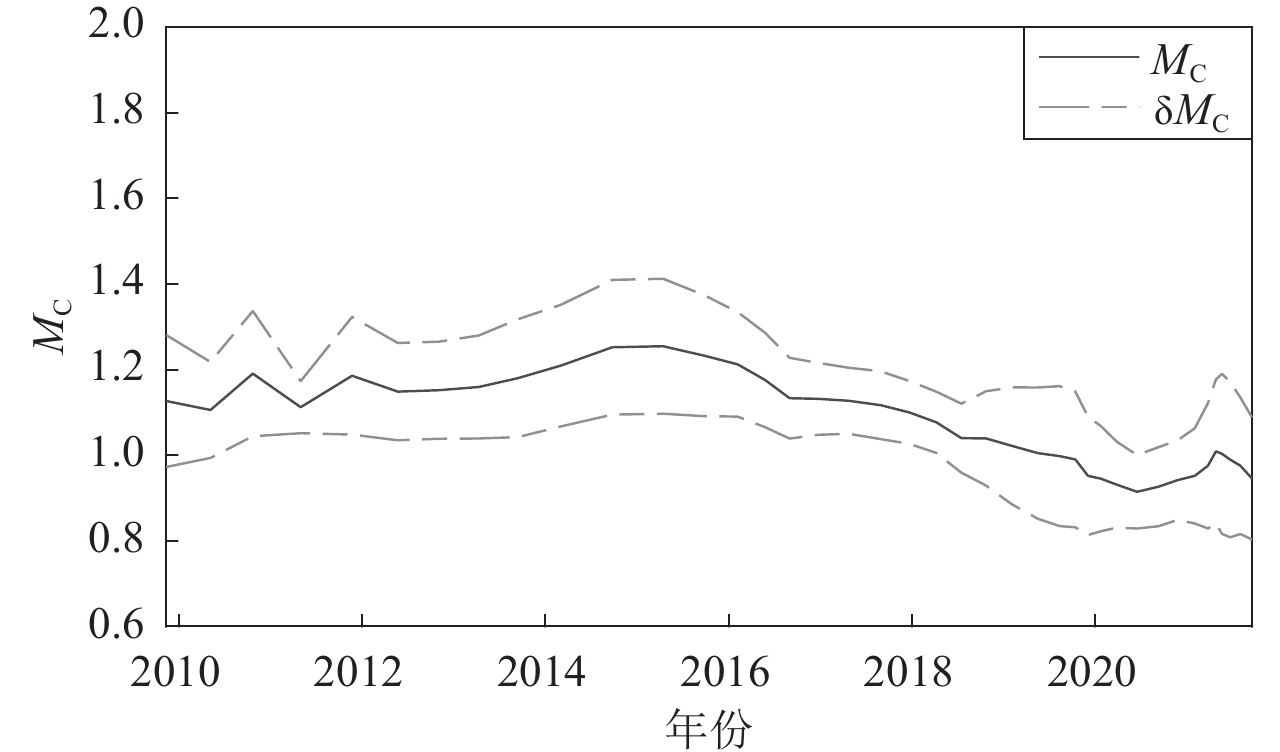
 下载:
下载:
